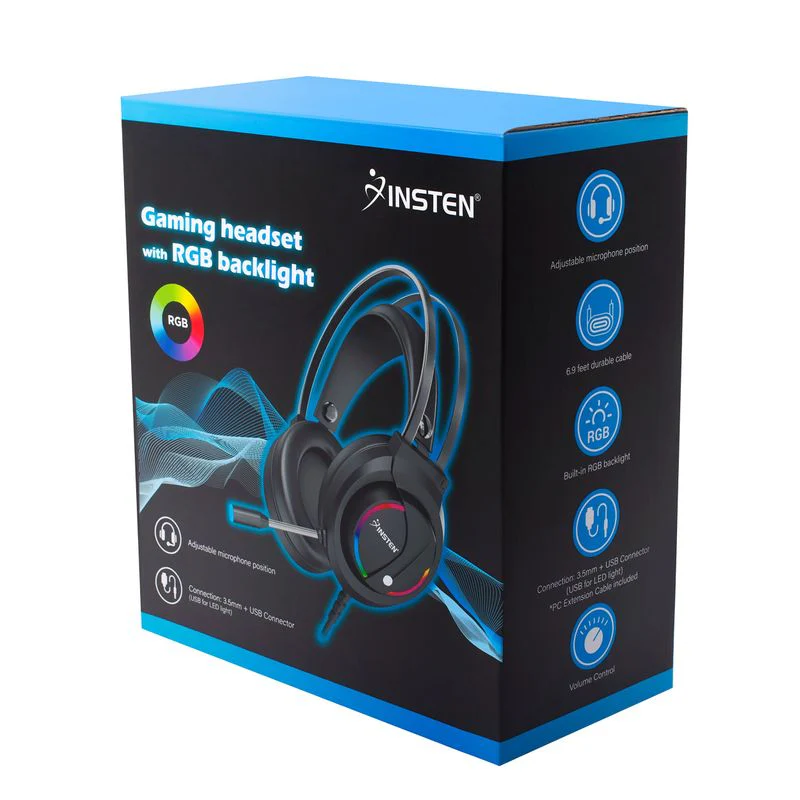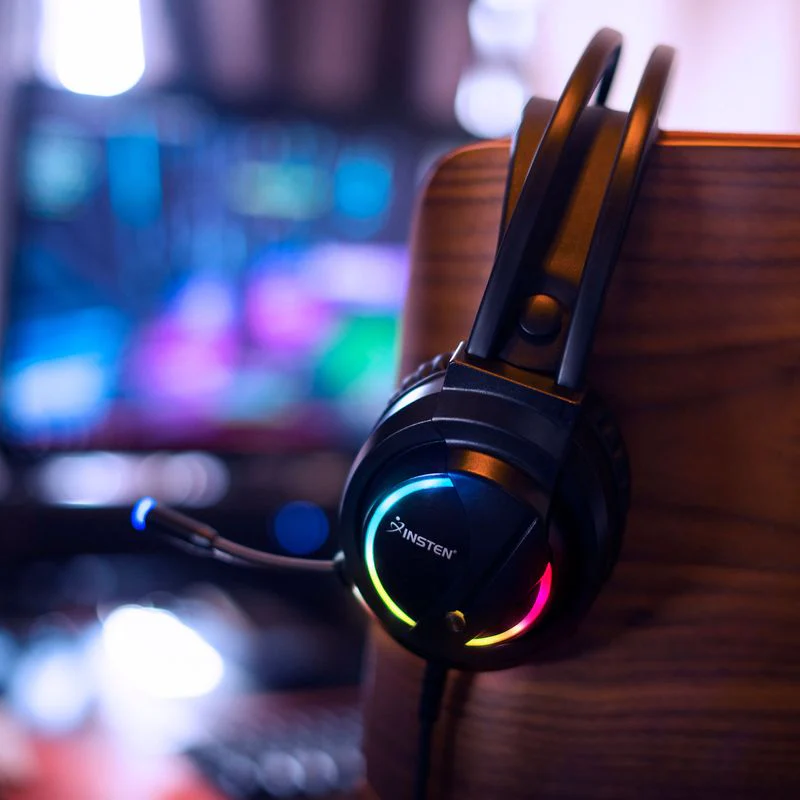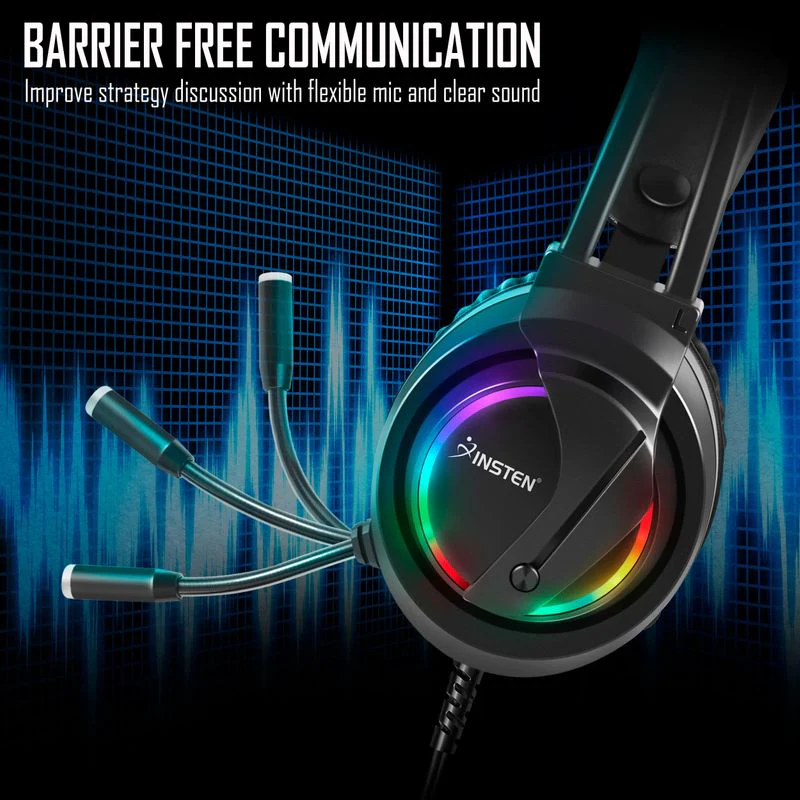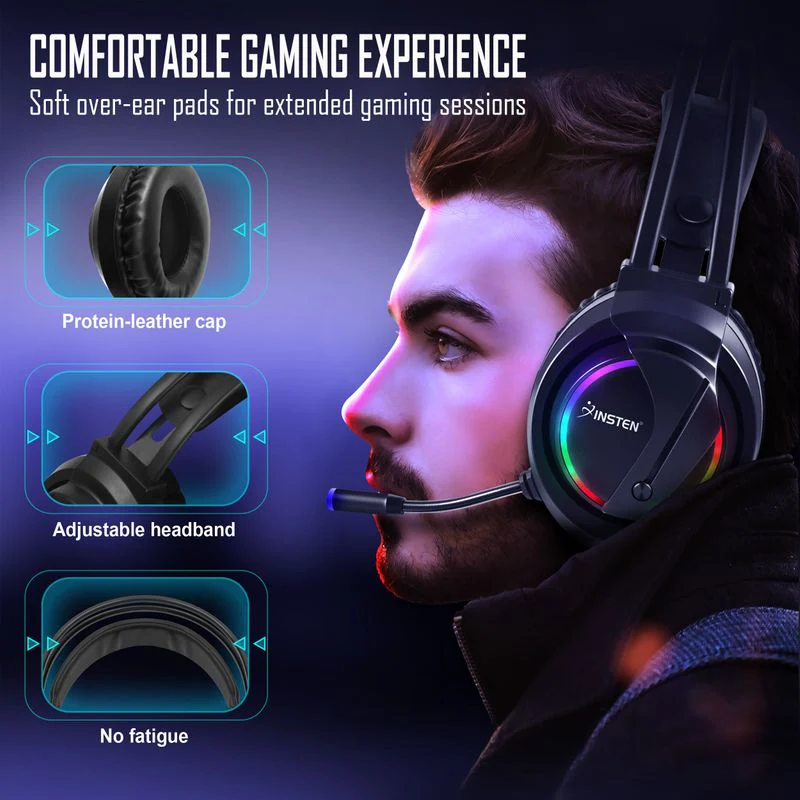I didn’t set out to add another wired headset to the stack next to my monitor. In fact, I spent a good chunk of this year trying to slim the fleet down to one daily driver for work calls and another strictly for weekend tournaments. But curiosity, that fickle little monster, tends to win. It certainly did the night I stumbled across the Insten Gaming Headset while scrolling late-night deals.
Table of Contents
The spec sheet sounded like every budget gamer’s wish list in bullet-point form 50 mm drivers, true cross-platform 3.5 mm support, detachable splitter for desktop rigs, a braided cable long enough to lasso a chair even a USB plug dedicated purely to keep the RGB breathing light alive. I’d never owned anything from Insten, yet something about the no-nonsense presentation (and the price that hovered just shy of the next pizza order) nudged me over the “why not” line. Forty-eight hours later a plain cardboard box with a small purple logo landed on my doorstep, and the timer on this review officially began.
Unboxing and First Impressions
Insten clearly understands there’s a middle ground between luxury foam cutouts and the dreaded clamshell prison. Flip the top, peel one strip of tape, and the headset sits inside a snug paper cradle wrapped in tissue no zip-ties, no plastic cuffs, just grab-and-go. A tiny booklet, a PC splitter cable, and a polite “thank you for choosing us” card round out the contents. The headset itself feels lighter than it looks, which threw me for a moment. The outer shells are matte black ABS with a satin finish that fends off fingerprints better than most glossy plastics, but it’s the metal headband rail peeking through each side that signals a seriousness you don’t always get in the sub-$40 segment.

What caught my eye first wasn’t the industrial design or even the memory-foam pads; it was the cable. Braided nylon the color of charcoal twists down into a rubber strain-relief, and it’s a full 6.9 feet long. That’s almost absurdly generous for couch gaming, yet it coils neatly enough to keep the desktop from looking like a spaghetti incident. The in-line remote sits mid-cable with a satisfyingly chunky volume wheel and a simple mic-mute slider no RGB there, no chat-mix gimmicks, just tactile control.
Firing up the RGB required a second step: slip the USB plug into any powered port and wait for the earcups to pulse. The effect cycles slowly through a muted rainbow, more of a gentle throb than a nightclub strobe. If you’re sensitive to flashing lights, don’t worry; the breathing pattern never spikes bright enough to turn your peripheral vision into a rave. And if your desk real estate is precious, the headset behaves perfectly fine with the USB unplugged no hiss, no loss of low-end, no sudden drop in impedance. It’s genuinely cosmetic, which I appreciate. Nothing drives me crazier than hardware that locks core audio features behind a powered USB even though the signal already runs through the analog jack.
Week One: Seamless Everyday Life
I always start with music, partly because it tells me more about a driver’s tonal balance than gunfire ever could, and partly because it’s how I ease into new gear. Arctic Monkeys’ “Four Out of Five” played first. The track opens with that tight snare hit and a roomy lead guitar, both of which came through crisp without the artificial sparkle that cheaper cans slap on to fake clarity. There’s a mid-bass lift roughly 90 Hz to 120 Hz if I had to guess by ear but it’s tasteful, not the muddy one-note thump you hear in bargain headphones at the checkout aisle. The 50 mm magnets dig surprisingly low: in Billie Eilish’s “Bury a Friend,” the sub-layer under her vocal buzzed my jaw ever so slightly, something you normally need a sealed set of studio monitors or a premium gaming rig to reproduce.

Switching to podcasts gave the first taste of how well the microphone rejects background clutter. I hopped into a Discord call with a friend who knows my voice well enough to spot tinny artifacts in seconds. “Whatever you’re using right now sounds better than the laptop mic by a mile,” he told me. No surprise there, but the kicker came next: “Actually, you could record a track with that.” Big praise from a guitarist who shames condenser mics for fun. The mic isn’t detachable, but it’s flexible enough to nudge into a twelve-to-one-o’clock angle and forget. Flip the mute slider and the boom LED blinks red simple, immediate feedback, no software overlay required.
My first multi-hour session followed: Final Cut Pro on a MacBook Pro, trimming B-roll and voiceovers. The headset’s rated impedance hovers around 32 ohms, so the built-in laptop amp drove it easily. Three hours in, the clamping force felt practically invisible; the protein-leather pads warmed but never crossed into sweaty. I lifted the left earcup once to make sure the apartment AC hadn’t quit because I couldn’t feel heat pooling around my ears. Lightweight is nice, but weight distribution is everything, and the Insten’s elastic suspension band dials the pressure so evenly I forgot the rig weighed just over 300 grams.
Game Nights and Split-Second Sound Cues
While narrative single-player titles show off a headset’s cinematic chops, competitive shooters expose weaknesses faster than any audio bench test. Valorant’s Haven map is ruthless about footsteps: you can predict a flank if the upper-mid frequencies sit just right. Out of the box the Insten places that footfall right where I expect it, slightly forward but not artificially wide. Reverb tails don’t smear into a wash like they do on some virtual-surround heavy sets, though you do get pseudo-surround processing built into the driver’s acoustics. It feels more 3D than plain stereo yet never drifts into the hollow cave effect that some “7.1” switch modes create. I left Windows in stereo, resisted the urge to EQ, and played on.

After two competitive matches, a ranked Overwatch session sealed the directional verdict. When a Reaper shadow-steps behind you the telltale whiff of his teleport swirl often blends into ambient crowd noise. On the Insten it came from a distinct two-o’clock angle, leading me to spin and flash fan the poor guy before he even left wraith form. Maybe it’s placebo; maybe it’s good tuning. Either way, footstep clarity feels on par with headsets twice the price.
Latency never enters the conversation with a wired plug, but I ran the headset through the 3.5 mm port on an Xbox Series X controller just to test electrical noise. None detected. The only hitch came from the older Xbox One controller in my closet: it still needs Microsoft’s proprietary stereo-headset adapter to accept any analog mic input. That quirk belongs to the console, not the headset, yet it’s worth noting if you haven’t upgraded your gamepad since the pre-Bluetooth era.
Microphone Deep Dive
I’m a sucker for mic tests because so few budget headsets deliver. This one surprised me enough to warrant a whole section. In a silent room, my vocal timbre landed warm with no nasality, a natural 2 kHz push for intelligibility, and a subtle roll-off around 80 Hz to keep plosives from rumbling. I dragged a desktop fan within two feet, crank-set to medium. The in-line noise gate cut most of the whoosh, though you still hear a faint breeze if you boost the recording 10 dB. That’s more than acceptable for in-game comms. On a Zoom call the auto-level algorithm pegged me at 70 percent input, just shy of clipping on laughs, which is exactly where I like my dynamic range.

Shouting tests are a guilty pleasure. I loaded up Payday 3 with two friends and proceeded to holler every time a cloaker blindsided me. No distortion. The diaphragm seems to have enough headroom to avoid splattering yell peaks. Do I endorse screaming? Maybe not, but it’s comforting to know I can without auditioning for a metal band.
Comfort Over the Long Haul
Two weeks in, the honeymoon phase typically ends; padding collapses or the headband reveals a pressure hotspot. None of that surfaced here. The memory foam under the faux-leather outer cover re-inflates overnight. There’s just enough give that your ear never touches the rigid driver plate. More impressive is how the suspension strip distributes load. It’s a thin elasticized fabric that self-adjusts when you pull the cups apart. A quick tug test felt like stretching a resistance band no creak, no micro-fractures in the plastic yokes, no crunch from cheap rivets. These small things matter when you’re head-banging in Rocket League overtime.

Weight sits right on the line between “forgotten” and “reassuring.” At roughly 310 grams, it’s lighter than many RGB-laden flagships yet heavy enough that it doesn’t shift if you jerk your head mid-recoil. I’ve worn featherweight cans that float so loosely the imaging shifts with every glance, so I’ll trade a few grams for stability any day.
Build Quality and Aesthetic Longevity
Design language is subjective. Some folks love aggressive angles; others want minimalist curves. Insten chooses the middle: a rounded triangular shell with a subtle slash grill. The RGB ring pulses rather than cycles hue-by-hue, giving a soft breathing vibe that matches the branding. I left it plugged in for evening streams and pulled the USB during daylight editing to avoid the glow reflecting in my glasses. Even after two weeks of daily plugging and unplugging, the connectors feel snug but not death-grip tight.
The braided cable deserves a second spotlight. Over the years I’ve killed more headsets by snagging cords on armrests than I care to admit. This one refuses to coil permanently; a quick finger-comb un-twists any kinks, and the strain-relief boots near both ends pass the bend test. That matters when you throw the headset into a backpack sharp folds can shear internal wires on cheap rubber insulation, but nylon weave spreads stress across fibers.
Travel Trials and Cross-Platform Reality
I pack light on family visits: a Switch OLED, Steam Deck, and phone. The Insten’s 3.5 mm jack made device swaps mindless. On the train I fed it from the Steam Deck’s top port and caught up on indie back-logs. Eighty-two inches of cable looked ridiculous across the fold-down tray table, but because it’s flexible and cloth-wrapped it pooled into a neat loop rather than stiffly springing into my neighbor’s lap. At my parents’ house I jacked into the Switch, then used the splitter to feed both mic and headphone ports on my old ThinkPad for a remote meeting. G HUB? iCue? Sonic Studio? None needed. Sometimes simplicity is king.
Durability Gut Check
Headsets in this bracket often break at the ear-cup yokes where the adjustment arm meets plastic. So I stress-tested on purpose: pulled the cups apart wider than my head, rotated them flat, then snapped them back. Zero squeaks. I’m not saying the thing is bullet-proof, but the internal metal band seems to carry the torsion rather than the plastic forks. Another notorious failure point is cable exit; yanking on the nylon sleeve each day for two weeks produced no slack shift, which tells me the solder join inside hasn’t budged.
One caveat: the faux-leather ear pads aren’t user-replaceable. They’re stitched rather than clipped, so once the surface flakes in six months or two years, depending on your climate you’ll need fabric glue or a third-party mod. Given the price category, that’s neither shocking nor a deal-breaker, but it’s worth noting if you sweat through pads in humid summers.
The Little Details That Win Me Over
- The volume wheel on the in-line remote has tactile detents single-finger rolls give predictable 2 or 3 dB boosts instead of flinging you from whisper to blast.
- The mic-mute slider glows faint red when engaged, a lifesaver during late-night multiplayer when roommates are sleeping a room away.
- There’s just enough passive isolation from the over-ear seal to cut AC hum, yet not so much that you miss the doorbell. Perfect for living in an apartment where missing deliveries is a daily fear.
- Braided cable can be wrapped around the headband for storage without snagging on the mic boom.
- RGB stays off when the USB is unplugged no stealth-draining laptop ports.
The Verdict After Three Intensive Weeks
Budget headsets carry an unfortunate stigma: boomy bass, muddy mids, plastic that cracks quicker than fortune cookies. The Insten Gaming Headset flips that narrative. No, it doesn’t dethrone audiophile stalwarts, nor does it break the mold on battery life because, well, there is no battery. But it nails the fundamentals: engaging sound that respects the frequency curve, a microphone clear enough for streaming out of the box, and comfort that competes with cans twice its weight class. Add plug-and-play versatility across every 3.5 mm port I own and you have a gadget that punches far above its price.
Will I retire my pricier wireless set for competitive nights? Probably not. The freedom of no cable still matters when I’m pacing during load screens. But when the battery icon flashes red or I need something I won’t baby on bus rides, the Insten is the headset I grab. And if you’re building a starter rig or hunting a gift for a sibling who swaps between Switch and PC daily it’s hard to recommend anything else without doubling the budget.
In the end that late-night impulse buy taught me something: value never gets old, and neither does reliable hardware. The Insten Gaming Headset proves you don’t have to mortgage your GPU fund to enjoy solid audio, clear comms, and a splash of RGB flair. Sometimes the simplest tool for the job is the one that just works every single time you plug it in, and that might be the highest praise of all.